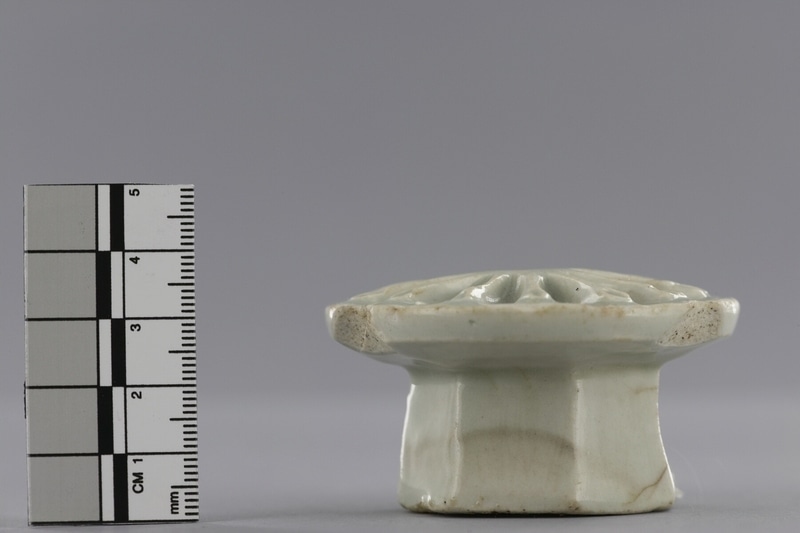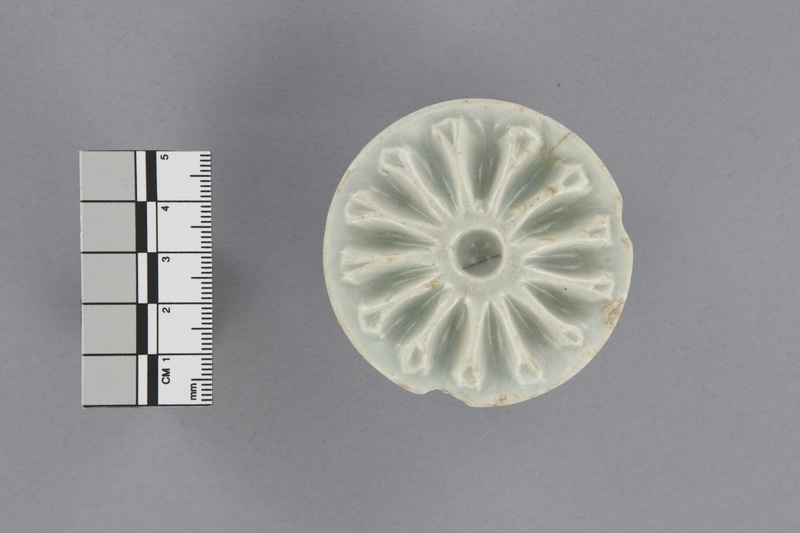Cake Mould Item Number: Ed1.355 from the MOA: University of British Columbia


Description
Mushroom-shaped, ceramic rice cake mould (tteoksal (떡살) with a seven-sided stem. The stem has a hole in one side; the top has a chrysanthemum design in relief.
History Of Use
Tteok (떡; rice cakes) with patterns made using tteoksal (rice cake moulds) were often given as gifts for various ceremonies, including weddings, birthdays, and New Year's day. Although the exact origin of tteoksal is unclear, the presence of jeolpyeon (절편; pounded rice cakes pressed with tteoksal) in literature from the mid sixteenth century (during the Joseon dynasty, 1392-1910) suggests its use during that time. These moulds are now rarely utilized due to changes in dietary habits, and a preference for cakes produced by mechanized rice cake shops. Tteok (떡) is a traditional Korean food made by steaming or boiling grains and then shaping them into various forms. It is uncertain when Koreans began making and eating tteok. Korean have enjoyed tteok as a snack for a long time and often share it with neighbours during holidays or special occasions. Tteok is made primarily with glutinous rice or non-glutinous rice and is categorized into four types: steamed, pounded, pan-fried, and boiled. As an important dish, tteok has always been served at royal banquets, family celebrations such as weddings, sixtieth birthday parties, and ancestral rites, as well as on the tables of ordinary people. Language characters that are stamped on the cakes usually symbolize concepts such as longevity, abundance, wealth, fortune, and protection from evil spirits.
Specific Techniques
Tteoksal (떡살) is a traditional Korean rice cake mould that functions like a stamp, to imprint patterns or shapes onto tteok (떡; rice cakes). The tteoksal is available in two types: wood (namu tteoksal; 나무 떡살) and pottery (baekja tteoksal; 백자 떡살 or sagi tteoksal; 사기 떡살). Wooden tteoksals have different patterns that can create multiple designs simultaneously and are generally rectangular or square. In contrast, pottery tteoksals are typically circular and have only one pattern, to make a single design. Tteoksal patterns can feature geometric designs, floral motifs, animal shapes, or language characters.
Item History
- Made in Korea during 1750
- Collected by Richard Pearson during 1978
- Owned by Richard Pearson before January 2, 1979
- Received from Richard Pearson (Seller) and Fyfe-Smith Memorial Oriental Collection Fund (Funding source) on January 2, 1979
What
Who
- Culture
- Korean
- Field Collector
- Richard Pearson
- Previous Owner
- Richard Pearson
- Received from
- Richard Pearson (Seller) and Fyfe-Smith Memorial Oriental Collection Fund (Funding source)
Where
- Holding Institution
- MOA: University of British Columbia
- Made in
- Korea
When
- Creation Date
- during 1750
- Collection Date
- during 1978
- Ownership Date
- before January 2, 1979
- Acquisition Date
- on January 2, 1979
Other
- Item Classes
- ceramics
- Condition
- good
- Accession Number
- 0506/0007